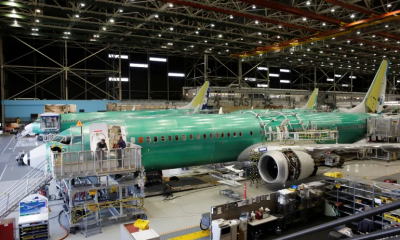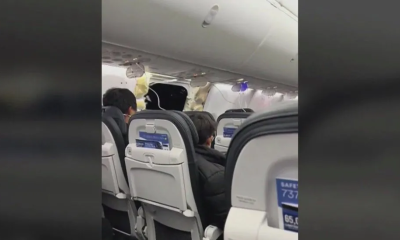Latest News
United Airlines finds loose bolts during inspections of Boeing 737 Max 9
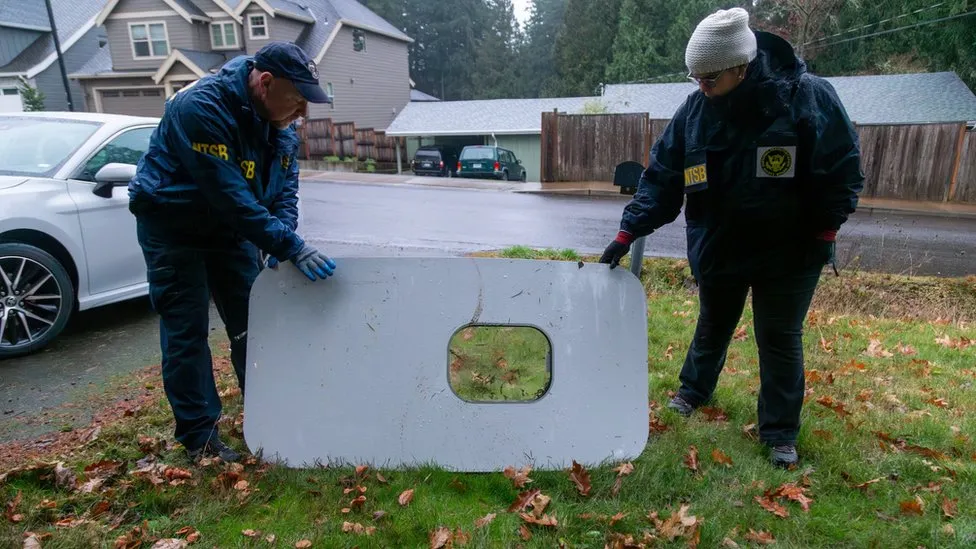
Bolts in need of “additional tightening” have been found during inspections of Boeing 737 Max 9s, United Airlines has said.
Inspections began after a section of the fuselage fell from an Alaska Airlines 737 Max 9 on Friday.
United Airlines said “installation issues” relating to door plugs would be “remedied” before the aircraft type would return to service. Some 171 planes of the same type remain grounded by the US regulator.
In its statement, United said: “Since we began preliminary inspections on Saturday, we have found instances that appear to relate to installation issues in the door plug – for example, bolts that needed additional tightening.”
The door plug is a piece of fuselage with a window that can be used as an emergency exit in certain configurations. It was this part of the Alaska Airlines plane which dramatically fell off mid-flight over the US state of Oregon, eventually landing in a teacher’s back garden.
The plane made an emergency landing and none of the passengers were injured.
The vast majority of Boeing 737 Max 9s used in the US are operated by United Airlines and Alaska, while Turkish Airlines, Panama’s Copa Airlines and Aeromexico have also grounded jets of the same model for inspections.
United said it had cancelled 200 flights as of Monday and expected significant cancellations on Tuesday. “We have been able to operate some planned flights by switching to other aircraft types, avoiding about 30 cancellations each on Monday and Tuesday,” United added.
Meanwhile on Monday, the Federal Aviation Administration (FAA), which regulates air travel in the US, said it had provided a checklist for operators to adhere to during inspections.
In a statement, the FAA said all 737 Max 9 aircraft would remain grounded until operators “complete enhanced inspections which include both left and right cabin door exit plugs, door components, and fasteners”. “Operators must also complete corrective action requirements based on findings from the inspections prior to bringing any aircraft back into service,” the statement added.
Flight 1282 reached 16,000ft (4.8km) when it began its emergency descent on Friday evening, according to flight tracking data. Images shared online – and later by investigators – showed a wide hole in the side of the craft, with oxygen masks dangling from the ceiling.
Passengers were quoted by The Oregonian newspaper as saying that a young boy seated near the affected area had his shirt ripped off by the force of the decompression.
The US National Transportation Safety Board (NTSB), which is leading an investigation into the incident, said pilots had reported pressurisation warning lights on three previous flights made by the specific Alaska Airlines Max 9 involved in the incident.
The jet had been prevented from making long-haul flights over water so that the plane “could return very quickly to an airport” in the event the warnings happened again, NTSB chief Jennifer Homendy said.
It is not clear if there is a link between the issues that led to those warnings, and the issue that caused the blowout on 5 January.
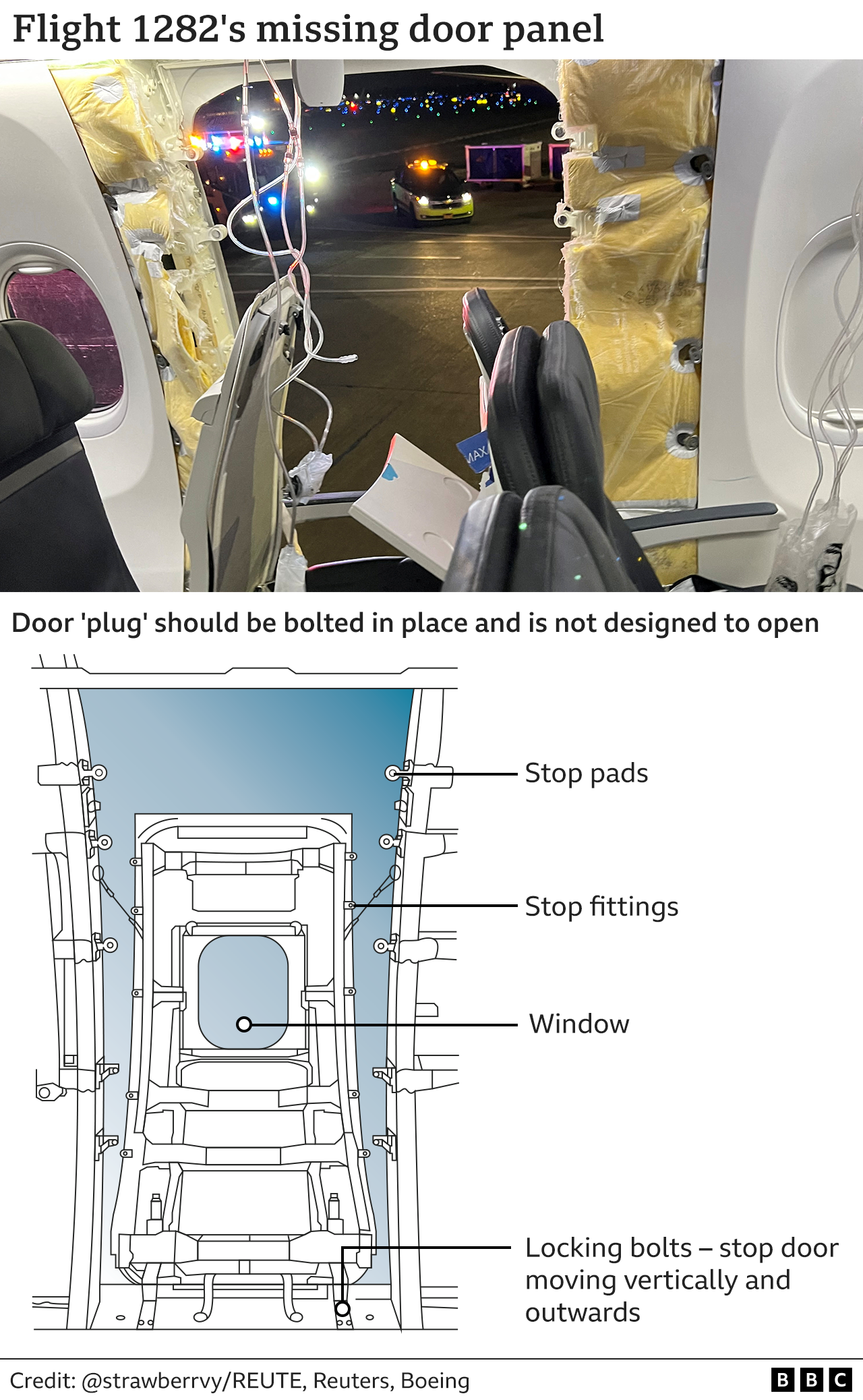
Alaska Airlines said in its most recent statement: “While we await the airworthiness directive (AD) inspection criteria from the FAA and Boeing, our maintenance teams are prepared and ready to perform the required inspections of the mid exit door plugs on our 737-9 Max fleet.
“The 737-9 Max grounding has significantly impacted our operation. We have cancelled 170 Sunday flights and 60 cancellations for Monday, with more expected.”
Boeing said in a statement: “Safety is our top priority and we deeply regret the impact this event has had on our customers and their passengers.”
The company’s 737 Max has been described as “the most scrutinised transport aircraft in history” after a series of safety issues.
In late 2018 and early 2019, two of its aircraft were lost in near identical incidents, off the coast of Indonesia and outside the Ethiopian capital Addis Ababa. A total of 346 people were killed. Both crashes were caused by flawed flight control software, which ultimately forced the planes into catastrophic dives, despite the best efforts of the pilots.
(BBC)
Latest News
Red Cross outraged over killing of medics by Israeli forces in Gaza
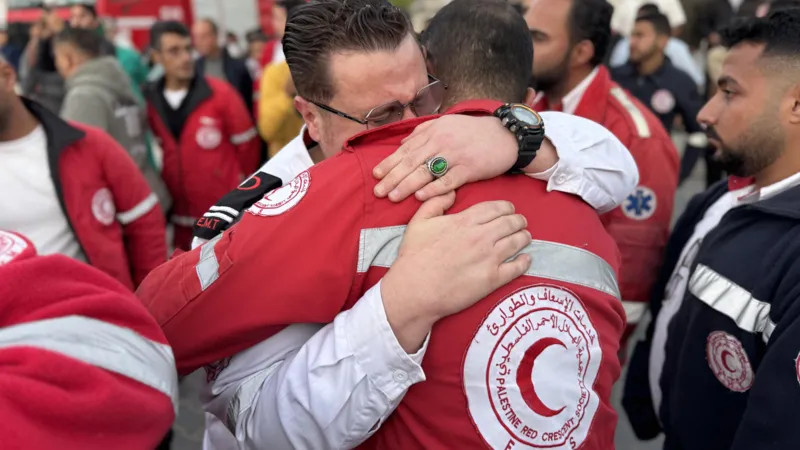
The Red Cross movement has expressed outrage that eight Palestinian medics were killed along with six Civil Defence first responders and a UN staff member by Israeli forces in southern Gaza.
Five ambulances, a fire truck and a UN vehicle were struck “one by one” in the al-Hashashin area on 23 March, according to a UN official. The 15 bodies were recovered from a “mass grave” on Sunday, he said.
The Palestine Red Crescent Society (PRCS) said a ninth medic was missing and accused Israel of targeting staff.
Israel’s military said troops fired on vehicles “advancing suspiciously” without headlights or emergency signals. It said a Hamas operative and “eight other terrorists” were among those killed.
The International Federation of Red Cross and Red Crescent Societies (IFRC) said in a statement on Sunday that the eight bodies of PRCS medics were retrieved “after seven days of silence and having access denied to the area of Rafah where they were last seen”.
The organisation identified those killed as ambulance officers Mostafa Khufaga, Saleh Muamer and Ezzedine Shaath, and first responder volunteers Mohammad Bahloul, Mohammed al-Heila, Ashraf Abu Labda, Raed al-Sharif and Rifatt Radwan.
It added that ambulance officer Assad al-Nassasra was “still missing”.
“I am heartbroken. These dedicated ambulance workers were responding to wounded people. They were humanitarians,” IFRC Secretary General Jagan Chapagain said.
“They wore emblems that should have protected them; their ambulances were clearly marked.
“Even in the most complex conflict zones, there are rules. These rules of International Humanitarian Law could not be clearer – civilians must be protected; humanitarians must be protected. Health services must be protected.”
The International Committee of the Red Cross (ICRC) said in a separate statement that it was “appalled” that the medics were killed while carrying out their work.
The head of the UN Office for the Co-ordination of Humanitarian Affairs (OCHA) in Gaza, Jonathan Whittall, said in a post on X on Sunday that its staff had supported the PRCS and Civil Defence in recovering the 15 bodies of the PRCS medics, Civil Defence first responders and UN staff member from “a mass grave… that was marked with the emergency light from one of their crushed ambulances”.
In a video that was posted online on Monday, Mr Whittall said: “Seven days ago, Civil Defence and PRCS ambulances arrived at the scene. One by one they were hit, they were struck. Their bodies were gathered and buried in this mass grave. We’re digging them out with uniforms, with their gloves on. They were here to save lives. Instead, they ended up in a mass grave.”
“Their vehicles… are crushed and dumped, covered in sand next to us. It’s an absolute horror what has happened here. This should never happen. Healthcare workers should never be a target.”
The head of the UN agency for Palestinian refugees (Unrwa), Philippe Lazzarini, said the UN staff member was one of its employees and that the burial of the bodies in “shallow graves” was “a profound violation of human dignity”.
The PRCS said it was devastated by the “massacre of our team”.
“[Israel’s] targeting of Red Crescent medics, despite the protected status of their mission and the Red Crescent emblem can only be considered a war crime punishable under international humanitarian law,” a statement added.
At the funeral for the medics on Monday, the father of Ashraf Abu Labda told the BBC: “They [Israeli troops] targeted the first vehicle, then the second and then the third. They killed them in cold blood.”
“We’ve been trying to look for them for eight days. They refused all co-ordination with Red Crescent, OCHA, or the UN. No-one can hold them accountable. Only God,” Nasser Abu Labda said.
The Israel Defense Forces (IDF) said in a statement that during an operation in southern Gaza on 23 March “several vehicles were identified advancing suspiciously toward IDF troops without headlights, or emergency signals, their movement was not co-ordinated in advance. Thus, IDF troops opened fire at the suspected vehicles.”
“Following an initial assessment, it was determined that the forces had eliminated a Hamas military operative, Mohammad Amin Ibrahim Shubaki, along with eight other terrorists from Hamas and the PIJ [Palestinian Islamic Jihad],” it added.
“Following the strike, the IDF co-ordinated with international organisations to facilitate the evacuation of the bodies.”
A previous IDF statement about the incident said an initial inquiry had determined that “some of the suspicious vehicles that were moving towards the troops were ambulances and fire trucks”. It also condemned what it called the “repeated use of civilian infrastructure by terrorist organisations”.
The IDF has not commented on the whereabouts of the missing PRCS medic. The OCHA said it was not clear if he was dead, had been detained or something else had happened.
Senior Hamas official Basem Naim condemned the attack.
“The targeted killing of rescue workers – who are protected under international humanitarian law – constitutes a flagrant violation of the Geneva Conventions and a war crime,” he said.
OCHA spokeswoman Olga Cherevko said there needed to be a full investigation to establish exactly what happened.
“They were aid workers in clearly marked vehicles, so this is why it’s obviously important to get to the bottom of it and get all the facts,” she told the BBC.
When asked about the IDF statements that Hamas and PIJ members had been killed, she said: “There are certain rules that all wars have, and this is why all parties to the conflict have to, obviously, abide by these rules. And this is what we’ve always said… But that doesn’t negate the fact that humanitarian aid workers and emergency responders shouldn’t be targeted.”
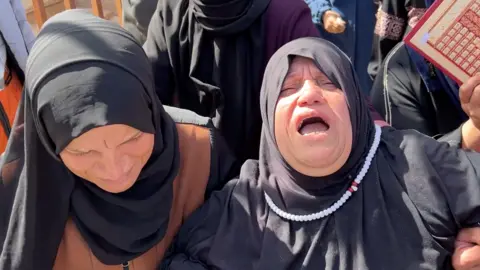
The incident in al-Hashashin happened on the same day that the IDF announced that its troops had encircled the nearby Tel al-Sultan area of Rafah and raided what it said was a Hamas command-and-control centre there.
On Monday, the IDF issued a sweeping new evacuation order for the entire Rafah region, telling all residents to head towards the nearby al-Mawasi humanitarian zone for their safety.
The IDF’s Arabic spokesperson warned that it was “returning to fight with great force to eliminate the capabilities of terrorist organizations in these areas”.
Israel launched its first major operation in Rafah last May, leaving large parts of it in ruins. However, tens of thousands of people returned to what was left of their homes in the city during the recent two-month-long ceasefire.
Israel renewed its aerial bombardment and ground offensive in Gaza on 18 March after the first phase of the ceasefire deal came to an end and negotiations on a second phase of the deal stalled.
At least 1,001 people have since been killed in Gaza since then, according to the territory’s Hamas-run health ministry.
The war erupted when Hamas attacked southern Israel on 7 October 2023, killing about 1,200 people and taking 251 back to Gaza as hostages.
The Israeli military launched a campaign to destroy Hamas in response, during which more than 50,350 people have been killed, the Gaza health ministry says.
[BBC]
Foreign News
French far-right leader Marine Le Pen barred from running for public office for five years
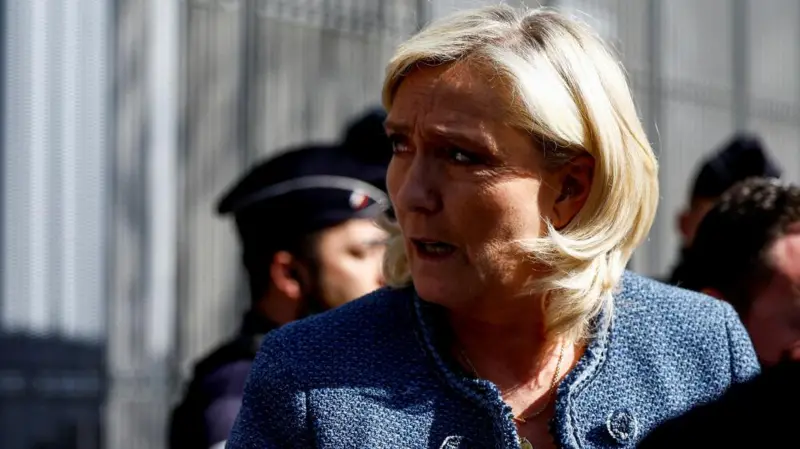
French far-right leader Marine Le Pen has been barred from running for public office for five years, meaning she would not be able to run in the 2027 French presidential election
She was found guilty of embezeeling European funds to finance her French far-right National Rally (RN) party.
[BBC]
Latest News
Laugfs LPG to cost more
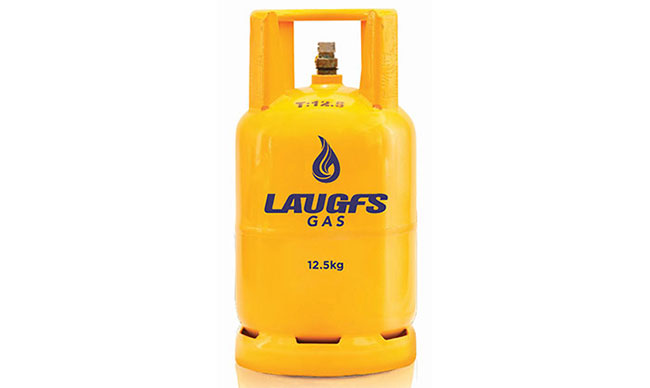
Laugfs Gas PLC, has increased its price of domestic Liquefied Petroleum Gas (LPG).
Accordingly,
The price of a 12.5 kg cylinder has been increased by Rs. 420 to Rs. 4,100
The price of a 5kg cylinder of Laugfs LPG has been increased by Rs.168 to Rs.1,645.
-

 Sports2 days ago
Sports2 days agoSri Lanka’s eternal search for the elusive all-rounder
-

 Features6 days ago
Features6 days agoCelebrating 25 Years of Excellence: The Silver Jubilee of SLIIT – PART I
-

 Business6 days ago
Business6 days agoCEB calls for proposals to develop two 50MW wind farm facilities in Mullikulam
-
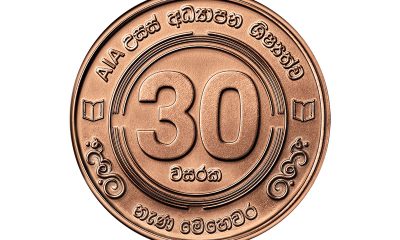
 Business4 days ago
Business4 days agoAIA Higher Education Scholarships Programme celebrating 30-year journey
-
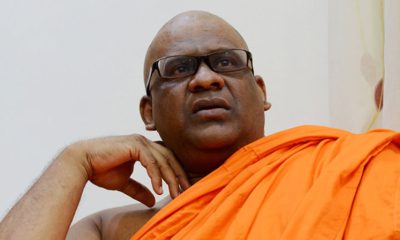
 News3 days ago
News3 days agoGnanasara Thera urged to reveal masterminds behind Easter Sunday terror attacks
-
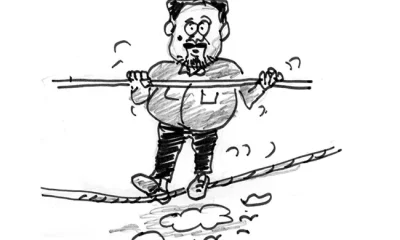
 Features6 days ago
Features6 days agoNotes from AKD’s Textbook
-

 News2 days ago
News2 days agoComBank crowned Global Finance Best SME Bank in Sri Lanka for 3rd successive year
-

 Features2 days ago
Features2 days agoSanctions by The Unpunished




